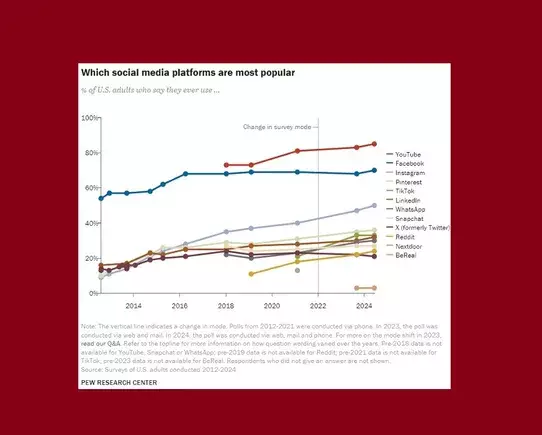The landscape of social media is constantly evolving, with platforms rising and falling in popularity. Recent research from Pew Research Center sheds light on the trends impacting U.S. adults’ engagement with social media platforms, offering insights into user behavior and preferences. While long-established players like YouTube and Facebook remain at the forefront, newer competitors are vying for attention, raising questions about the relevance of platforms like X (formerly Twitter).
YouTube continues to reign supreme as a social media platform, a position that seems to transcend the traditional definition of social media. While it primarily serves as a video-sharing site, its widespread adoption among various demographics reinforces its significance in digital communications. In fact, the Pew Research survey indicates that a significant portion of U.S. adults is using YouTube, which can partly be attributed to its vast library of engaging content that caters to various interests.
The survey data, collected from a substantial sample size of 5,626 U.S. adults, illustrates a broader trend of video consumption dominating social media interactions. Users are gravitating towards platforms that facilitate more visual engagement, with sites like YouTube taking center stage. This trend may signal a shift in how we perceive social media, as traditional interactions evolve toward more visual storytelling rather than text-based dialogue.
Alongside YouTube, Facebook and Instagram maintain significant usage rates among U.S. adults, highlighting the robust infrastructure of Meta’s platforms. Despite challenges like privacy concerns and the increasing popularity of competing apps, Facebook’s appeal persists, particularly among older adults. This demographic has shown consistent engagement with the platform, reinforcing its position as a primary communication tool.
Instagram, on the other hand, has captured the interests of both Millennials and Gen Z, continuing to grow alongside changing social dynamics. However, TikTok is noteworthy for its rapid rise, particularly among younger audiences who favor its short-form video format. While the Pew data did not report significant growth for TikTok in the past year, the platform’s unique format still compels users to spend more prolonged periods engaged with its content compared to traditional platforms such as Facebook.
While the Pew Research findings emphasize who is using what, they also neglect to address how much time users spend on each platform — which could provide deeper insights into user engagement. Reports indicate that TikTok users often outpace their Facebook counterparts in time spent on the app, revealing a more immersive experience. This raises questions about the metrics used to assess engagement and the implications of user behavior on platform longevity.
Moreover, while TikTok and Snapchat are popular among younger users, platforms like LinkedIn and WhatsApp have seen modest increases in usage, suggesting varied patterns of engagement among different age groups. The rise of Pinterest and Reddit also points to a diversification of interests among social media users, signaling a marketplace with room for niche platforms despite the overarching dominance of larger players.
As for X (Twitter), the platform is experiencing a slight decline, although not as drastic as some may assume. Its continued use indicates that, while it may be losing some traction, it remains a critical player in the social media landscape — especially for real-time conversations and trending topics. Nevertheless, its appeal among users appears to be waning, with other platforms capturing the attention and engagement of younger demographics.
BeReal, a platform that generated initial excitement, showcases the volatility of user interest in social apps. Gaining traction briefly, it has not sustained its appeal, demonstrating that the social media cycle is marked by rapid shifts in user preferences.
Understanding these trends is essential for marketers aiming to connect with their target audiences effectively. As different demographics flock to various platforms, creating a well-informed strategy that aligns with where consumers are most active can significantly enhance outreach and engagement.
As the social media sphere continues to shift, keeping a watchful eye on user behaviors and preferences is pivotal for successfully navigating this dynamic landscape. Recognizing the nuances of audience engagement and platform relevance can provide marketers with the tools they need to thrive in the ever-changing digital age.


Leave a Reply
You must be logged in to post a comment.